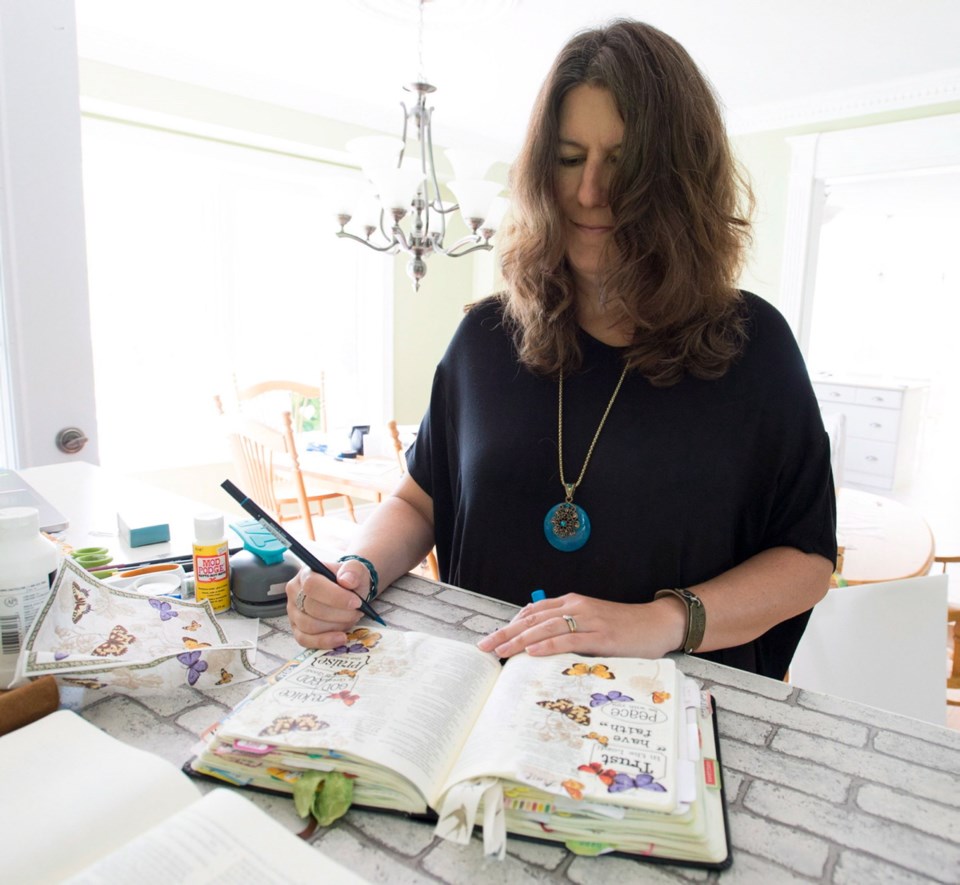TORONTO — When mixed-media artist Marjolaine Walker is feeling creative, she reaches for her pens, paints, stamps and clip art. Then she grabs her Bible — and fills it with decorative flourishes.
The Ottawa-area mother-of-four says this is how she likes to unwind, and connect with God.
“Some people definitely think it’s sacrilegious or whatever to make a mark in the Bible,” says the 43-year-old, who lives in Richmond, Ont.
“To me, a Bible that is read and studied does not look brand new. It just doesn’t.”
Walker’s unorthodox hobby is called Bible-journaling — not quite scrapbooking, and definitely not your traditional Bible study.
It essentially involves writing out or illustrating biblical concepts in the book itself.
This can involve elaborate lettering, drawing, painting, stickers and pasting — often in the margin or interleaves, but sometimes covering the actual text.
It’s a Pinterest-primed pastime that’s taken hold of a dedicated following, mostly involving younger Christian women looking for a new way to express their faith, says Shanna Noel, a pastor’s wife who is credited with starting the movement in 2014.
Noel says she inadvertently kicked off a trend when she posted images of her own Bible art online.
“Journaling Bibles were only meant really for taking notes with your ballpoint pen in the margin and that’s kind of how people were using them. I got mine and just instinctively started doing this creative note-taking process in my Bible,” the 36-year-old says from her home in Olympia, Washington.
“I was just so on fire for it but I didn’t want to share it with anyone because I thought this was wrong, I didn’t want to go to like Christian jail or anything. But once I did start sharing on my blog it just kind of went viral from there.”
Overwhelmed by comments and questions about how to start, she started a Facebook group that has swelled to 40,000 members and set up an Instagram account called Illustrated Faith that boasts 104,000 followers.
Noel also shares her techniques at conferences, craft supply stores and churches, and sells journaling products online.
She says one recent gig took her to South Africa to run a class for 125 participants. She heads to Edmonton in January to teach at a conference there.
Evangelizing seems to be a powerful element to the movement, and comes just as organized religion in general faces steady declines in membership.
Deb Tempelmeyer of Parasource Marketing & Distribution says her Paris, Ont., company supplies wide-margin Bibles favoured by mainline Protestant churches — including Anglican, United and Presbyterian — but doesn’t have a Catholic version.
Avid crafter Joanne Fink, who is Jewish, says she’s been incorporating Old Testament scripture into her work for decades, but doesn’t mark up her Bible.
“We consider it sacrilegious to write in the Bible,” says Fink, co-author of the recently released Bible Journaling: Creative Techniques to Express Your Faith.
“My Jewish friends, if any of them are inclined to do this, would do it in sketchbooks and journals, the way I usually do.”
And that’s OK, she says, noting there are no rules.
“In my mind, Bible journaling refers to the intentional practice of reading scripture and then writing or illustrating your response to that scripture. And it’s a way for growing close to God.”
Walker says she grew up Roman Catholic and recalls being told that only a priest could read and truly understand the Bible.
“It was like a sacred object that you would never write in it or anything like that,” she says, adding that she no longer identifies with a specific denomination.
She now attends a Free Methodist Church where she says congregants are encouraged to dig into scripture.
Bible journaling fits in well with that kind of attitude.
“There are literally thousands of women that found it hard to read the Bible because they weren’t connecting and when they started Bible journaling they started doing Bible studies,” says Walker.
“It’s not just an art form. It’s literally time spent with Him.”



